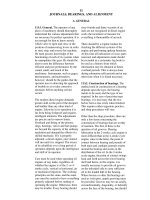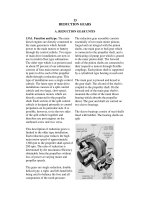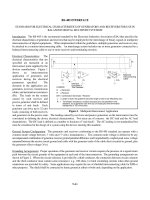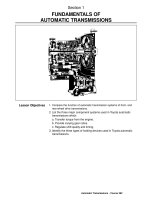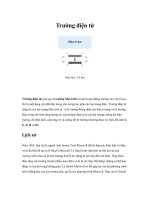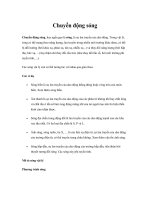Tài liệu Biologically Inspired Technologies pptx
Bạn đang xem bản rút gọn của tài liệu. Xem và tải ngay bản đầy đủ của tài liệu tại đây (15.63 MB, 579 trang )
BIOMIMETICS
Biologically Inspired Technologies
BIOMIMETICS
Biologically Inspired Technologies
EDITED BY
Yoseph Bar-Cohen
A CRC title, part of the Taylor & Francis imprint, a member of the
Taylor & Francis Group, the academic division of T&F Informa plc.
Boca Raton London New York
Jet Propulsion Laboratory (JPL),
California Institute of Technology
Pasadena, California, USA
Published in 2006 by
CRC Press
Taylor & Francis Group
6000 Broken Sound Parkway NW, Suite 300
Boca Raton, FL 33487-2742
© 2006 by Taylor & Francis Group, LLC
CRC Press is an imprint of Taylor & Francis Group
No claim to original U.S. Government works
Printed in the United States of America on acid-free paper
10987654321
International Standard Book Number-10: 0-8493-3163-3 (Hardcover)
International Standard Book Number-13: 978-0-8493-3163-3 (Hardcover)
Library of Congress Card Number 2005048511
This book contains information obtained from authentic and highly regarded sources. Reprinted material is quoted with
permission, and sources are indicated. A wide variety of references are listed. Reasonable efforts have been made to publish
reliable data and information, but the author and the publisher cannot assume responsibility for the validity of all materials
or for the consequences of their use.
No part of this book may be reprinted, reproduced, transmitted, or utilized in any form by any electronic, mechanical, or
other means, now known or hereafter invented, including photocopying, microfilming, and recording, or in any information
storage or retrieval system, without written permission from the publishers.
For permission to photocopy or use material electronically from this work, please access www.copyright.com
( or contact the Copyright Clearance Center, Inc. (CCC) 222 Rosewood Drive, Danvers, MA
01923, 978-750-8400. CCC is a not-for-profit organization that provides licenses and registration for a variety of users. For
organizations that have been granted a photocopy license by the CCC, a separate system of payment has been arranged.
Trademark Notice: Product or corporate names may be trademarks or registered trademarks, and are used only for
identification and explanation without intent to infringe.
Library of Congress Cataloging-in-Publication Data
Bar-Cohen, Yoseph.
Biomimetics : biologically inspired technologies / Yoseph Bar-Cohen.
p. cm.
Includes index.
ISBN 0-8493-3163-3 (alk. Paper)
1. Biomimetics. 2. Bionics I. Title.
QP517.B56B37 2005
600—dc22 2005048511
Visit the Taylor & Francis Web site at
and the CRC Press Web site at
Taylor & Francis Group
is the Academic Division of Informa plc.
3163_Discl.fm Page 1 Wednesday, September 21, 2005 3:14 PM
Abstract
Over the 3.8 billion years since life is estimated to have begun to appear on Earth, evolution has
resolved many of nature’s challenges leading to lasting solutions with maximal performance using
minimal resources. Nature’s inventions have always inspired human achievement and have led to
effective algorithms, methods, materials, processes, structures, tools, mechanisms, and systems.
There are numerous examples of biomimetic successes including some that are simple copies of
nature, such as the use of fins for swimming. Other examples were inspired by biological capabil-
ities with greater complexity including the mastery of flying that became possible only after the
principles of aerodynamics were better understood. Some commercial implementations of biomi-
metics can be readily found in toy stores, where robotic toys are increasingly appearing and
behaving like living creatures. More substantial benefits of biomimetics include the development
of prosthetics that closely mimic real limbs as well as sensory-enhancing microchips that are being
used to interface with the brain to assist in hearing, seeing, and controlling instruments. In this book,
various aspects of the field of biomimetics are reviewed, examples of inspiring biological models
and practical applications of biomimetics are described, and challenges and potential directions of
the field are discussed.
Bar-Cohen : Biomimetics: Biologically Inspired Technologies 3163_C000 Final Proof page v 26.9.2005 8:20pm
v
Bar-Cohen : Biomimetics: Biologically Inspired Technologies 3163_C000 Final Proof page vi 26.9.2005 8:20pm
Editor
Yoseph Bar-Cohen is a physicist who has specialized in electroactive materials and mechanisms,
and ultrasonics nondestructive evaluation (NDE). A senior research scientist and group supervisor,
Advanced Technologies, at the Jet Propulsion Laboratory (JPL), he is also responsible for the
Nondestructive Evaluation and Advanced Actuators (NDEAA) Lab ( />The NDEAA lab established in 1991 is listed on the JPL’s Chief Technologies as one of the JPL
unique facilities. Bar-Cohen is a fellow of two technical societies: The International Society for
Optical Engineering (SPIE) and American Society for Nondestructive Testing (ASNT). He
received his PhD in Physics (1979) from the Hebrew University, Jerusalem, Israel. His notable
discoveries are the leaky Lamb waves (LLW) and polar backscattering phenomena in composite
materials. Bar-Cohen has over 280 publications as author and coauthor, and 16 registered patents.
He has made numerous presentations at national and international conferences and chaired and co-
chaired 27 conferences. As coauthor, editor, and coeditor, he has written and edited 4 books and 11
conference proceedings. He is the initiator of the SPIE Conference on electroactive polymers
(EAP), which he has been chairing since 1999. He challenged engineers worldwide to develop a
robotic arm driven by EAP to wrestle with humans and win, and he organized the competition as
part of the EAPAD conferences. The first of this competition took place on March 7, 2005. For his
contributions to the field of EAP, he has been named one of five technology gurus who are pushing
tech’s boundaries by Business Week in April 2003. His scientific and engineering accomplishments
have earned him many honors and awards including the NASA Exceptional Engineering Achieve-
ment Medal in 2001, two SPIE awards — the NDE Lifetime Achievement Award (2001) and the
Smart Materials and Structures Lifetime Achievement Award (2005).
Bar-Cohen : Biomimetics: Biologically Inspired Technologies 3163_C000 Final Proof page vii 26.9.2005 8:20pm
vii
Bar-Cohen : Biomimetics: Biologically Inspired Technologies 3163_C000 Final Proof page viii 26.9.2005 8:20pm
Acknowledgments
The research at Jet Propulsion Laboratory (JPL), California Institute of Technology was carried out
under a contract with National Aeronautics and Space Administration (NASA).
The editor would like to thank David Hanson, University of Texas at Dallas and Hanson
Robotics, Inc. for his drawing of the book cover page. Further, the editor would like to acknow-
ledge and express his appreciation to the following individuals who took the time to review various
book chapters. Their contribution is highly appreciated and it has helped to make this book of
significantly greater value to its readers. The 65 individuals who served as reviewers of chapters in
this book are:
Rajat Agrawal Department of Mechanical Engineering, University of Delaware,
Newark, DE
Tony Aponick Foster-Miller, Inc., Waltham, MA
Limor Bar-Cohen Department of Public Policy, School of Public Affairs, University of
California, Los Angeles, CA
Jon Barnes Institute of Biomedical and Life Sciences, University of Glasgow,
Scotland, U.K.
William Baumgartner Cardiac Surgery, Johns Hopkins Medical Institutions, Baltimore, MD
Peter J. Bentley University College London, London, U.K.
Reinhard Blickhan Science of Motion, Institute of Sportscience, Friedrich Schiller
University, Jena, Germany
Paul Calvert Department of Textile Sciences, Dartmouth, MA
Robert E. Cleland University of Washington, Seattle, WA
Jack Cohen Newent, Glasgow, Scotland, U.K.
John Conte Cardiac Surgery, Johns Hopkins Medical Institutions, Baltimore, MD
Bob Dennis University of North Carolina, Department of Biomedical
Engineering, Chapel Hill, NC
Ezequiel Di Paolo Sussex University, Brighton, U.K.
Tammy Drezner California State University, Fullerton, Fullerton, CA
Zvi Drezner California State University, Fullerton, Fullerton, CA
Wolfgang Fink Jet Propulsion Laboratory/Caltech, Pasadena, CA
Greg Fischer Strategic Analysis, Inc., Arlington, VA
Robert A. Freitas Jr. Institute for Molecular Manufacturing, Los Altos, CA
Udi Gazit University of Tel Aviv, Israel
Vincent Gott Cardiac Surgery, Johns Hopkins Medical Institutions, Baltimore,
MD
Bar-Cohen : Biomimetics: Biologically Inspired Technologies 3163_C000 Final Proof page ix 26.9.2005 8:20pm
ix
H. Thomas Hahn Mechanical and Aerospace Engineering, University of California,
Los Angeles, CA
Roger T. Hanlon Marine Resources Center, Marine Biological Laboratory, Woods
Hole, MA
Walter Herzog Human Performance Laboratory, University of Calgary, Calgary,
Alberta, Canada
Neville Hogan Massachusetts Institute of Technology, Cambridge, MA
George Jeronimidis Centre for Biomimetics, School of Construction Management and
Engineering, Reading University, Reading, Berkshire, U.K.
Brett Kennedy Jet Propulsion Laboratory, Pasadena, CA
Roy Kornbluh SRI International, Menlo Park, CA
Dimitris C. Lagoudas Texas Institute for Intelligent Bio-Nano Materials, and Structures for
Aerospace Vehicles, Texas A&M University, College Station, TX
Matthias Langer Universita
¨
tsklinikum Ulm, Ulm, Germany
Luke Lee Berkeley Sensor and Actuator Center, University of California,
Berkeley, CA
Cornelius Leondes University of California, Los Angeles, CA
Hod Lipton Mechanical and Aerospace Engineering, and Computing and
Information Science, Cornell University, Ithaca, NY
Jian R. Lu Department of Physics, University of Manchester Institute of
Science and Technology (UMIST), Manchester, New Hampshire
Michael Lysaght Biomedical Engineering Artificial Organs Laboratory, Department
of Molecular Pharmacology and Biotechnology, Brown University,
Providence, RI
John Madden University of British Columbia, Vancouver, BC, Canada
John Main DARPA, Washington, DC
Ajit Mal Mechanical and Aerospace Engineering, University of California,
Los Angeles, CA
Paul S. Malchesky International Center for Artificial Organs and Transplants,
Painesville and STERIS Corporation, Mentor, OH
George A. Marcoulides California State University, Fullerton, CA
Adi Marom Research Artifacts Center Engineering, The University of Tokyo,
Japan
William Megill University of Bath, Bath, U.K.
Chris Melhuish Intelligent Autonomous Systems Laboratory, CEMS Faculty,
University of the West of England, Bristol, U.K.
Kenneth Meijer Universiteit Maastricht, The Netherlands
Dharmendra Modha Computer Science Department, IBM Almaden Research Center,
White Plains, New York
Yuki Nose Department of Surgery, Houston, TX
Michael E. DeBakey Department of Surgery, Houston, TX
Qibing Pie Department of Materials Science and Engineering, University of
California, Los Angeles, CA
Glen Pennington East Tennessee State University Medical Center, Johnson City, TN
Gerald H. Pollack University of Washington, Seattle, WA
Gill Pratt F.W. Olin College of Engineering, Needham, MA
Sumitra Rajagopalan Biomedical Engineering Institute, Universite
´
de Montre
´
al,
Montre
´
al, Canada
Roy E. Ritzmann Department of Biology, Case Western Reserve University,
Cleveland, OH
Nick Rowe Botanique et Bioinformatique, Montpellier, France
Bar-Cohen : Biomimetics: Biologically Inspired Technologies 3163_C000 Final Proof page x 26.9.2005 8:20pm
x Acknowledgments
Said Salhi School of Mathematics and Statistics, University of Birmingham,
Birmingham U.K.
Gernot Schmierer BMW Group, Munich, Germany
Bill Seaman Digital Media Department, Rhode Island School of Design,
Providence, RI
Ji Su NASA Langley Research Center, Langley, VA
Mikhail Svinin RIKEN BMC, Nagoya, Japan
Ken Toda Department of Zoology, Graduate School of Science, Kyoto
University, Japan
Tihamer ‘‘Tee’’ Toth-Fejel General Dynamics Advanced Information Systems, Arlington, VA
Blaire Van Valkenburgh Department of Ecology and Evolutionary Biology at University of
California, Los Angeles, CA
James Weiland Doheny Eye Institute, USC, Los Angeles, CA
Stefan Wo
¨
lfl Klinik fu
¨
r Innere Medizin Friedrich Schiller Universita
¨
t, Jena,
Germany
Julian F.V. Vincent Department of Mechanical Engineering, Centre for Biomimetics and
Natural Technologies, University of Bath, Bath, U.K.
Steven Vogel Duke University, Durham, NC
Masaki Yamakita Tokyo Institute of Technology, Tokyo, Japan
Bar-Cohen : Biomimetics: Biologically Inspired Technologies 3163_C000 Final Proof page xi 26.9.2005 8:20pm
Acknowledgments xi
Bar-Cohen : Biomimetics: Biologically Inspired Technologies 3163_C000 Final Proof page xii 26.9.2005 8:20pm
Contributors
Rajat N. Agrawal
Doheny Eye Institute
University of Southern Carolina
Los Angeles, California
Pramod Bonde
School of Medicine
The Johns Hopkins University
Baltimore, Maryland
Justin Carlson
Departments of Biomedical Engineering,
Chemical and Biological Engineering,
and Biology
Tufts University
Medford, Massachusetts
Robert G. Dennis
Department of Biomedical Engineering
University of Michigan
Ann Arbor, Michigan
Tammy Drezner
California State University-Fullerton
Fullerton, California
Zvi Drezner
California State University-Fullerton
Fullerton, California
Atul Dubey
Department of Mechanical and Industrial
Engineering
Northeastern University
Boston, Massachusetts
Shail Ghaey
Departments of Biomedical
Engineering, Chemical and Biological
Engineering, and Biology
Tufts University
Medford, Massachusetts
Stanislav N. Gorb
Max Planck Institute for Metals
Research
Stuttgart, Germany
Keyoor Chetan Gosalia
North Carolina State University
Raleigh, North Carolina
David Hanson
University of Texas at Dallas
Hanson Robotics, Inc.
Los Angeles, California
Robert Hecht-Nielsen
Computational Neurobiology
University of California
San Diego, California
Hugh Herr
Massachusetts Institute of
Technology
Media Laboratory
Cambridge, Massachusetts
Shigeyuki Hosoe
RIKEN BMC
Nagoya, Japan
Bar-Cohen : Biomimetics: Biologically Inspired Technologies 3163_C000 Final Proof page xiii 26.9.2005 8:20pm
xiii
Mark S. Humayun
Doheny Eye Institute
University of Southern Carolina
Los Angeles, California
Masami Ito
RIKEN BMC
Nagoya, Japan
David L. Kaplan
Departments of Biomedical Engineering,
Chemical and Biological Engineering,
and Biology
Tufts University
Medford, Massachusetts
Gianluca Lazzi
North Carolina State University
Raleigh, North Carolina
Luke P. Lee
Berkeley Sensor and Actuator Center
Department of Bioengineering
University of California
Berkeley, California
Hod Lipson
Mechanical and Aerospace Engineering, and
Computing and Information Science
Cornell University
Ithaca, New York
Zhiwei Luo
RIKEN BMC
Nagoya, Japan
Constantinos Mavroidis
Department of Mechanical and Aerospace
Engineering
Rutgers University
Newark, New Jersey
Kenneth Meijer
Department of Biomedical Engineering
Technische Universiteit Eindhoven
Eindhoven, The Netherlands
Sean Moran
Departments of Biomedical Engineering,
Chemical and Biological Engineering,
and Biology
Tufts University
Medford, Massachusetts
Juan C. Moreno
Instituto de Automa
´
tica Industrial
Madrid, Spain
Sia Nemat-Nasser
Center of Excellence for Advanced
Materials, Mechanical and Aerospace
Engineering
University of California
San Diego, California
Syrus Nemat-Nasser
Center of Excellence for Advanced Materials,
Mechanical and Aerospace Engineering
University of California,
San Diego, California
Thomas Plaisted
Center of Excellence for Advanced Materials,
Materials Science and Engineering
University of California,
San Diego, California
Hans H.C.M. Savelberg
Department of Health Sciences
Universiteit Maastricht
Maastricht, The Netherlands
Rainer Stahlberg
Department of Biology
University of Washington
Seattle, Washington
Anthony Starr
Center of Excellence for Advanced Materials,
Mechanical and Aerospace Engineering
University of California
San Diego, California
Bar-Cohen : Biomimetics: Biologically Inspired Technologies 3163_C000 Final Proof page xiv 26.9.2005 8:20pm
xiv Contributors
Robert Szema
Department of Bioengineering
University of California
Berkeley, California
Minoru Taya
Department of Mechanical Engineering
University of Washington
Seattle, Washington
Cam Anh Tran
Departments of Biomedical Engineering,
Chemical and Biological Engineering,
and Biology
Tufts University
Medford, Massachusetts
Ajay Ummat
Department of Mechanical and Industrial
Engineering
Northeastern University
Boston, Massachusetts
Alireza Vakil Amirkhizi
Center of Excellence for Advanced Materials,
Mechanical and Aerospace Engineering
University of California
San Diego, California
Julian F.V. Vincent
Department of Mechanical Engineering
The University of Bath
Bath, U.K.
James Weiland
Doheny Eye Institute
University of Southern Carolina
Los Angeles, California
Hidenori Yokoi
Massachusetts Institute of Technology
Cambridge, Massachusetts
Shuguang Zhang
Massachusetts Institute of Technology
Cambridge, Massachusetts
Xiaojun Zhao
Massachusetts Institute of Technology
Cambridge, Massachusetts
and
Institute for Nanobiomedical Technology and
Membrane Biology
Sichuan University
Sichuan, China
Bar-Cohen : Biomimetics: Biologically Inspired Technologies 3163_C000 Final Proof page xv 26.9.2005 8:20pm
Contributors xv
Bar-Cohen : Biomimetics: Biologically Inspired Technologies 3163_C000 Final Proof page xvi 26.9.2005 8:20pm
Contents
1. Introduction to Biomimetics: The Wealth of Inventions in
Nature as an Inspiration for Human Innovation 1
Yoseph Bar-Cohen
2. Biological Mechanisms as Models for Mimicking:
Sarcomere Design, Arrangement, and Muscle Function 41
Kenneth Meijer, Juan C. Moreno, and Hans H.C.M. Savelberg
3. Mechanization of Cognition 57
Robert Hecht-Nielsen
4. Evolutionary Robotics and Open-Ended Design Automation 129
Hod Lipson
5. Genetic Algorithms: Mimicking Evolution and
Natural Selection in Optimization Models 157
Tammy Drezner and Zvi Drezner
6. Robotic Biomimesis of Intelligent Mobility, Manipulation, and Expression 177
David Hanson
7. Bio-Nanorobotics: A Field Inspired by Nature 201
Ajay Ummat, Atul Dubey, and Constantinos Mavroidis
8. Molecular Design of Biological and Nano-Materials 229
Shuguang Zhang, Hidenori Yokoi, and Xiaojun Zhao
9. Engineered Muscle Actuators: Cells and Tissues 243
Robert G. Dennis and Hugh Herr
10. Artificial Muscles Using Electroactive Polymers 267
Yoseph Bar-Cohen
11. Biologically Inspired Optical Systems 291
Robert Szema and Luke P. Lee
12. Multifunctional Materials 309
Sia Nemat-Nasser, Syrus Nemat-Nasser, Thomas Plaisted,
Anthony Starr, and Alireza Vakil Amirkhizi
13. Defense and Attack Strategies and Mechanisms in Biology 341
Julian F.V. Vincent
Bar-Cohen : Biomimetics: Biologically Inspired Technologies 3163_C000 Final Proof page xvii 26.9.2005 8:20pm
xvii
14. Biological Materials in Engineering Mechanisms 365
Justin Carlson, Shail Ghaey, Sean Moran, Cam Anh Tran, and David L. Kaplan
15. Functional Surfaces in Biology: Mechanisms and Applications 381
Stanislav N. Gorb
16. Biomimetic and Biologically Inspired Control 399
Zhiwei Luo, Shigeyuki Hosoe, and Masami Ito
17. Interfacing Microelectronics and the Human Visual System 427
Rajat N. Agrawal, Mark S. Humayun, James Weiland,
Gianluca Lazzi, and Keyoor Chetan Gosalia
18. Artificial Support and Replacement of Human Organs 449
Pramod Bonde
19. Nastic Structures: The Enacting and Mimicking of Plant Movements 473
Rainer Stahlberg and Minoru Taya
20. Biomimetics: Reality, Challenges, and Outlook 495
Yoseph Bar-Cohen
Index 515
Bar-Cohen : Biomimetics: Biologically Inspired Technologies 3163_C000 Final Proof page xviii 26.9.2005 8:20pm
xviii Contents
1
Introduction to Biomimetics:
The Wealth of Inventions in Nature
as an Inspiration for Human Innovation
Yoseph Bar-Cohen
CONTENTS
1.1 Introduction 2
1.2 Mimicking and Inspiration of Nature 4
1.2.1 Synthetic Life 6
1.3 Artificial Life 7
1.4 Artificial Intelligence 8
1.5 Nature as a Model for Structures and Tools 9
1.5.1 Constructing Structures from Cells 9
1.5.2 Biologically Inspired Mechanisms 10
1.5.2.1 Digging as the Gopher and the Crab 10
1.5.2.2 Inchworm Motors 11
1.5.2.3 Pumping Mechanisms 12
1.5.2.4 Controlled Adhesion 13
1.5.2.5 Biological Clock 13
1.5.3 Biologically Inspired Structures and Parts 13
1.5.3.1 Honeycomb as a Strong, Lightweight Structure 13
1.5.3.2 Hand Fan 13
1.5.3.3 Fishing Nets and Screens 15
1.5.3.4 Fins 15
1.5.4 Defense and Attack Mechanisms in Biology 16
1.5.4.1 Camouflage 16
1.5.4.2 Body Armor 16
1.5.4.3 Hooks, Pins, Sting, Syringe, Barb, and the Spear 17
1.5.4.4 Decoy 18
1.5.5 Artificial Organs 19
1.6 Materials and Processes in Biology 19
1.6.1 Spider Web — Strong Fibers 20
1.6.2 Honeybee as a Multiple Materials Producer 21
1.6.3 Swallow as a Clay and Composite Materials Producer 21
1.6.4 Fluorescence Materials in Fireflies and Road Signs 21
1.6.5 Impact Sensitive Paint Mimicking Bruised Skin 22
Bar-Cohen : Biomimetics: Biologically Inspired Technologies DK3163_c001 Final Proof page 1 21.9.2005 6:40pm
1
1.6.6 Mimicking Sea Creatures with Controlled Stiffness Capability 23
1.6.7 Biology as a Source for Unique Properties and Intelligent Characteristics 23
1.6.8 Multifunctional Materials 23
1.6.9 Biomimetic Processes 23
1.7 Bio-Sensors 24
1.7.1 Miniature Sensors in Biomimetic Robots 24
1.7.2 MEMS-Based Flow Detector Mimicking Hair Cells with Cilium 25
1.7.3 Collision Avoidance Using Whiskers 25
1.7.4 Emulating Bats’ Acoustic Sensor 25
1.7.5 Acoustic and Elastic Wave Sensors 26
1.7.6 Fire Monitoring 26
1.7.7 Sense of Smell and Artificial Nose 26
1.7.8 Sense of Taste and Artificial Tongue 27
1.8 Robotics Emulating Biology 28
1.8.1 Artificial Muscles 31
1.8.2 Aerodynamic and Hydrodynamic Mobility 32
1.8.3 Social and Other Biological Behaviors 33
1.9 Interfacing Biology and Machines 34
1.9.1 Telepresence and Teleoperation 34
1.10 Conclusions 36
Acknowledgments 36
References 37
Websites 40
1.1 INTRODUCTION
Imagine a smart microchip that is buried in the ground for a long time. Upon certain triggering
conditions this chip begins to grow and consume materials from its surroundings, converting them
into energy and structural cells. As the chip grows further, it reconfigures its shape to become a
mobile robot. Using its recently created mobility, the chip becomes capable of searching and
locating critical resources consuming them to grow even more. The type and function of the
specific cells that are formed depend on each cell’s role within the growing structure. This
science-fiction scenario is inspired by true-life biology such as the growth of chicks from an egg
or plants from a seed. Yet given all our technological advances, it is still impossible to engineer
such a reality.
Bionics as the term for the field of study involving copying, imitating, and learning from biology
was coined by Jack Steele of the US Air Force in 1960 at a meeting at Wright–Patterson Air Force
Base in Dayton, Ohio (Vinc ent, 2001). Otto H. Schmitt coined the term Biomimetics in 1969
(Schmitt, 1969) and this field is increasingly involved with emerging subjects of science and
engineering. The term itself is derived from bios, meaning life, and mimesis, meaning to imitate.
This new science represents the study and imitation of nature’s methods, designs, and processes.
While some of its basic configurations and designs can be copied, many ideas from nature are best
adapted when they serve as inspiration for huma n-made capabilities. In this book, both biologically
inspired and biologically mimicked technologies are discussed, and the terms biology, creatures,
and nature are used synonymously.
Nature has always served as a model for mimicking and inspiration for humans in their desire
to improve their life. By adapting mechanisms and capabilities from nature, scientific approaches
have helped humans understand related phenomena and associated principles in order to engineer
novel devices and improve their capability. The cell-based structure, which makes up the majority
of biological creatures, offers the ability to grow with fault-tolerance and self-repair, while doing
Bar-Cohen : Biomimetics: Biologically Inspired Technologies DK3163_c001 Final Proof page 2 21.9.2005 6:40pm
2 Biomimetics: Biologically Inspired Technologies
all of the things that characterize biological systems. Biomimetic structures that are made of
multiple cells would allow for the design of devices and mechanisms that are impossible with
today’s capabilities. Emerging nano-technologies are increasingly enabling the potenti al of such
capabilities.
The beak of birds may have served as an inspiring model for the development of the tweezers
and the tong. While it is difficult to fin d evidence that it had inspired early humans, one can argue
that since nature invented this device first it was a widely known concept way before humans began
making tweezers and tongs. The mimicking of the beak is illustrated graphically on the cover page
of this book, where a virtual mirror is drawn to represent the inspiration of adapting nature’s
capabilities. Although enormous advances have been made in the field of biomimetics, nature is
still far superior to what we are capable of making or adapting. Given the limitation of today’s
technology, copying nature may not be the most effective approach. Many examples exist where
humans using nature as inspiration have used its principles to invent far more effective solutions;
flying is one such example. This book focuses on the technologies that resulted from both
mimicking and being inspired by biology.
Nature evolves by responding to its needs and finding solutions that work, and most
importantly, that last through innumerable generations while passing the test of survival to
reach its next generation. Geological studies suggest the presence of life on Earth as early as
3.8 billion years ago (Lowman, 2002). Specifically, in Greenland, a series of ancient metamorph-
osed sediments were found with carbon isotope signatures that appear to have been produced by
organisms that lived when the sediments were deposited. Furthermore, fossil evidence
indicates that ancient bacteria, Archea (Archaebacteria), have existed on the Earth for at least
3.5 billion year s (Schopf, 1993; Petr, 1996). After billions of years of trial and error exper iments,
which turn failures to fossils, nature has created an enormous pool of effective solutions. It is
important to note however that the extinction of a species is not necessarily the result of a failed
solution; it can be the result of outside influences, such as significant changes in climate, the
impact of asteroids, volcanic activity, and other conditions that seriously affect the ability of
specific creatures to survive. The adaptations of nature have led to the evolution of millions of
species — each with its own way of meeting its needs in harmony with the environment
(Research Report, 1992).
Through evolution, nature has ‘‘experimented’’ with various solutions to challenges and
has improved upon successful solutions. Organisms that nature created, which are capable of
surviving, are not necessarily optimal for their technical performance. Effectively, all they need
to do is to survive long enough to reproduce. Living systems archive the evolved and accumulated
information by coding it into the species’ genes and passing the information from generation to
generation through self-replication. Thus, through evolution, nature or biology has experimented
with the principles of physics, chemistry, mechanical engineering, materials science, mobility,
control, sensors, and many other fields that we recognize as science and engineering. The process
has also invol ved scaling from nano and macro, as in the case of bacteria and virus, to the macro and
mega, including our life scale and the dinosaurs, respect ively. Although there is still doubt
regarding the reason for the extinction of creatures such as the mammoth, it may be argued that
the experiment in the evolution of mega-scale terrestrial biology failed. While marine creatures
such as the whales survived, nature’s experiment with large size terrestrial biology ended with the
extinction of the prehistoric mega-creatures (e.g., dinosaurs and mammoths). Such creatures can
now be found only in excavation sites and natural history museums.
As the evolution process continues, biology has created and continues to create effective
solutions that offer great models for copying or as inspiration for novel engineering methods,
processes, materials, algorithms, etc. Adapting biology can involve copying the complete appear-
ance and function of specific creatures like the many toys found in toy stores, which are increas-
ingly full of simplistic imitations of electro-mechanized toys such as dogs that walk and bark, frogs
that swim, and such others. However, while we have copied or adapted man y of nature’s solutions
Bar-Cohen : Biomimetics: Biologically Inspired Technologies DK3163_c001 Final Proof page 3 21.9.2005 6:40pm
Introduction to Biomimetics 3
an enormous number of mysteries remain unravelled. Humans have learned a lot from nature and
the results help surviving generat ions and continue to secure a sustainable future.
This book reviews the various aspects of biomimetics from modeling to applications as well as
various scales of the field from cell to macro-structures. Chapter 1 provides an overview of the field
of biomimetics addressing technologies that mimic biology versus those that adapt its principles
using biology as an inspiring model. Chapter 2 describes biological mechanisms as models for
mimicking. Chapter 3 examines the mechanization of cogni tion and the creation of knowledge, and
the various aspects of processing by the brain as a basis for autonomous operation. Another angle of
this issue is covered in Chapter 4, where evolutionary robotics and open-ended design automation
are described. One of the widel y used biologically inspired algorithms, the genetic algorithm, is
described in Chapter 5 using a mathematical imitation of evolution and natural selection. Robotics
is increasingly inspired by biology and robots that are close imitation of animals and humans are
emerging with incredible capability as described in Chapter 6. The details of making a biological
system as a model are discussed in the following chapters where biologically inspired molecular
machines are described in Chapter 7 and molecular design of biological and nano-materials in
Chapter 8. The next two chapters deal with biological and artificial muscles with Chapter 9
describing engineered muscle actuators and Chapter 10 covering the topic of artificial muscles
using electroacti ve polymers (EAP). An important aspect of biology and systems is the use of
sensors and Chapter 11 covers the topic of vision as an example of bio-sensors. One of the unique
characteristics of biological materials and structures is their multifunctionality and these materials
are covered in Chapter 12. Other aspects of biological systems that offer important models for
imitation are described in the chapters that follow. Chapter 13 covers defense and attack strategies
and mechanisms in biology; Chapter 14 covers biological materia ls in engineering mechanisms;
Chapter 15 describes mechanisms and appl ications of functional surfaces in biology. One of the
critical issues of operating systems is that of cont rol and Chapter 16 examines the issue of
biomimetic and biologically inspired control. Interfacing the body with artificial devices is covered
in the next two chapters with Chapter 17 describing interfacing microelectronics and the human
body and Chapter 18 covering artificial support and replacement of human organs. Plants also serve
as a model for inspiration and Chapter 19 describes the topic of nastic structures, which are active
materials that enact and mimic plant movements. Chapter 20 of this book includes an overview,
description, challenges, and outlook for the field of biomimetics.
This chapter provides an overview of some of the key biology areas that inspired humans to
produce an imitation. This includes making artificial, synthesized, inspired, and copied mechan-
isms, as well as processes, techniques, and other biomimetic aspects. There are many examples but
only a select few are given in this chapter to illustrate the successes and the possibilities.
1.2 MIMICKING AND INSPIRATION OF NATURE
Biology offers a great model for imitation, copying and learning , and also as inspiration for new
technologies (Benyus , 1998). Flying was inspired by birds using human developed capabilities
(Figure 1.1), whereas the design and function of fins, which dive rs use, was copied from the legs of
water creatures such as the seal, goose, and frog. But the distinction between technologies resulting
from the various adaptive approaches is not always clear. For instance, studying photosynthesis in a
leaf may lead some to argue that the invention of the solar cell is an imitation, while others may see
it as a biologically inspired technology. While both photosynthesis and solar cell use sunlight as a
source of energy, they neither perform the same process nor create the same output.
Biologically inspired terms such as male and female connectors, as well as teeth of a saw are
common, and it is very clear to us what they mean. Other terms derived from biology the usage of
which are clearly understood include the heart to suggest the center, the head to indicate the
beginning, the foot or tail to imply the end, the brain to describe a computing system . Likewise, the
Bar-Cohen : Biomimetics: Biologically Inspired Technologies DK3163_c001 Final Proof page 4 21.9.2005 6:40pm
4 Biomimetics: Biologically Inspired Technologies
use of the terms intelligent or smart suggests the emulation of biological capabilities with a certain
degree of feedback and decision making. Other terms include aging, fatigue, death, digestion, life
cycle, and even ‘‘high on the food chain’’ (referring to a high management level). In the world of
computers and software many biological terms are used to describe aspects of technology including
virus, worm, infection, quarantine, replicate, and hibernate. Other forms of imitating nature
comprise virtual reality, simulations and copying of structures and materials. Shapes are also
used as recognizable terms where the dog-bone provides a clear description of the shape of test
coupons that are used to measure the tensile module and strength of materials. Structures are also
widely copied, for example the honeycomb. Used for its efficient packing structure by bees (which
is different from its use in aerospace — for low weight and high strength), the honeycomb has the
same overall shape in both biological and aerospace structures. It could be reasoned that the
honeycomb structures, which are used in many of the aircraft structures of today’s airplanes,
were not copied from the bees (Gordon, 1976). However, since it is a commonly known structure
invented by nature many years before humans arrived, no patent can be granted in the ‘‘patent
court’’ of nature to the first human who produced this configuration. Generally, biological materials
(Chapter 14), including silk and wool that are widely used in clothing, have capabilities that surpass
those made by humans. This superb capability of biological materials, structures, and processes has
been the subject of imitation in artificial versions of materials.
Plants can also offer a model for imitation (Chapter 19). Besides their familiar characteristics,
some plants exhibit actuation capabilities that are expected of biological creatures. Such plants
include the mimosa and the Sensitive Fern (Onoclea sensibilis) that fold or close their leaves
when touched (Figure 1.2). There are also bug-eating plants with a leaf derived trap ‘‘door’’
that closes and traps unsuspecting bugs that enter to become prey. Examples of such plants include
the Venus Flytrap (Dionaea muscipula) and the Pitcher plant (Sarracenia purpurea) (Figu re 1.3).
The sunflower tracks the sun’s direction throughout the day to maximize exposure to its light. Plants
have evolved in various ways, and som e have produced uncom mon solutions to their special needs.
For example, some desert plants have flowers that produce the malodor of rotten meat, and some
even have a brown color that appears very much like decomposing meat. Such characteristics are
critical for these plants to attract flies, rather than bees, to pollinate their flowers.
Figure 1.1 The image of the Egyptian God Khensu with wings (left) illustrates the age-old fantasy of humans of
being able to fly. (Photographed by the author at the Smithsonian Museum, Washington, DC.) This fantasy turned
to reality with the use of aerodynamic principles leading to enormous capabilities such as the supersonic passenger
plane, the Concord on the right. (Photographed by the author at the Boeing Aerospace Museum, Seattle,
Washington.)
Bar-Cohen : Biomimetics: Biologically Inspired Technologies DK3163_c001 Final Proof page 5 21.9.2005 6:40pm
Introduction to Biomimetics 5
1.2.1 Synthetic Life
Advances in understanding and unraveling the genetic code, and the ability to manipulate and
splice genes have made the possibility of creating synthetic life an increasing reality. Biologists
are now able to engineer bacteria and develop drugs that otherwise must be extracted from rare
plants at very high costs. Further, bacteria and yeast are being produced to build proteins with
synthetic amino acids having novel properties that are impossible to find in nature. Researchers
are also working on assembling simple cells from basic components with an ability that is
Figure 1.2 The Sensitive Fern (O. sensibilis form the Woodsiaceae family of plants) has its leaves open (left)
until they are touched (right).
Figure 1.3 (See color insert following page 302) Bug-eating plants with traps that developed from their leaf.
Bar-Cohen : Biomimetics: Biologically Inspired Technologies DK3163_c001 Final Proof page 6 21.9.2005 6:40pm
6 Biomimetics: Biologically Inspired Technologies




